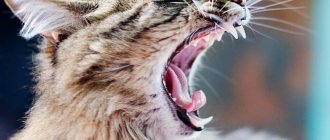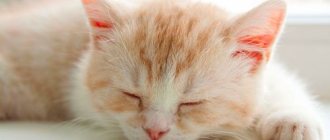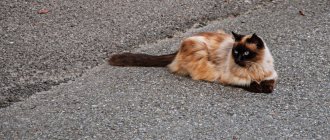Beautiful and thick fur is an indicator of health and the pride of every cat (if he is not a Sphynx). Therefore, the sudden appearance of bald spots on the head and neck, on the back and hind legs will worry both the animal and the owner.
Advice from experienced breeders and felinologists will help every concerned owner notice signs of alopecia in a cat in time and cure this disease.
What is alopecia
In cats that constantly live in an apartment and do not go outside, shedding occurs almost all year round with greater or less intensity. It is normal for pets to lose a lot of fur. During periods of heavy shedding, a cat's fur may fall out in clumps, and the coat will noticeably thin out. If the animal feels well, its nose is clean and moist, and its appetite is excellent, there is nothing to worry about.
But sometimes hair loss occurs according to the “wrong” scenario: the cat’s hair falls out and non-healing bald spots form. In this case, the owner should be concerned: perhaps these are alarming symptoms of alopecia. This term means “baldness”, “baldness”.
With pathological alopecia, bald spots form on the cat's body - areas devoid of fur. They can be located on the back, symmetrically on the animal’s hind legs and sides, and on the ears. Possible places for hair loss: muzzle, stomach, groin area.
Based on the causes of baldness, the disease is divided into:
- Symptomatic alopecia. It is associated with a specific disease, and baldness acts as a concomitant symptom.
- Idiopathic alopecia. Acts as an independent disease.
In most cases, baldness is accompanied by itching, redness and flaking of the skin. The condition is differentiated by location on the cat’s body into:
- diffuse alopecia – fur is lost abundantly throughout the body;
- localized alopecia - only one area is affected;
- partial alopecia - there may be several affected areas.
Why does a cat go bald - reasons
01. The first reason is not at all terrible: it may be physiological reasons or seasonal changes in fur in especially fluffy individuals.
02. The second reason is adenitis. Most often it affects male cats. It appears as follows:
- crusts appear on the head and ears;
- the fur can be pulled out without causing pain or harm to the cat.
Since this disease is extremely rare, it is better to visit a veterinarian so that he can make an accurate diagnosis and prescribe treatment. While the case is pending, you can purchase a special detergent or shampoo.
03. The third reason is food allergies. Digestion in cats and cats occurs in a special way. Allergies can occur from any product.
Therefore, you should remember that you cannot share your food with your cat. It is better for her to purchase balanced food, with the necessary vitamins and supplements.
If circumstances force you to change food, it needs to be checked for the degree of digestibility, giving the pet a small amount. Read about how and what to feed your cat here.
04. The fourth reason may be injection. The fur will begin to fall off at the injection site. Gradually everything will fall into place; in this case there is no need to treat hair loss.
05. The fifth reason is seborrhea. Because of it, your furry friend suffers from peeling skin and spreads an unpleasant odor. You will have to have your blood tested at the veterinary hospital. Your veterinarian will recommend shampoo and fatty acids.
06. The sixth reason is lichen. To avoid this disease, you need to keep your cat clean. Well, if this happens, the doctor will prescribe medications.
07. The seventh reason is infestation with fleas or lice. It’s easy to get rid of them by using special hygiene products, but you should monitor your cat more carefully.
08. The eighth reason can be considered stress. When can a cat get it? Due to their personality traits, some animals may begin to go bald from stress during moving, changing housing, or participating in an exhibition. The cat is going bald on the hips, abdomen, and inner sides of the paws.
At this time, the pet needs increased attention and care. In addition, you should distract the animal from the constant desire to lick its fur, because in this case this procedure only provokes its loss.
09. The ninth reason is hormonal imbalance. Spayed or neutered animals may go bald due to hormonal imbalance. The cat behaves calmly. Treatment of baldness from this cause will be associated with taking hormonal medications, again prescribed by a doctor. The fur will be restored completely.
Types of baldness
To make a correct diagnosis and prescribe adequate treatment, the doctor needs to find out what type of baldness the animal suffers from:
- The most “popular” and most common type of alopecia in cats is self-induced or self-induced. The culprit of this type of baldness is the animal itself. Bald spots and bald spots in a cat occur due to frequent licking, scratching or mechanical irritation of the same area of skin. The cause of this behavior may be injury or itching. In this case, an Elizabethan collar will help. The device is placed around the cat's neck and prevents its unwanted actions.
- With spontaneous baldness, the hair falls off for no apparent reason. The task of a veterinary dermatologist is to determine the source of the problem and eliminate it.
- A common occurrence in cats is hypotrichosis. With this type of lesion, the fur on the entire body of the animal or in certain areas of it looks as if it had been eaten by a moth. The ends of the hairs are split and broken off. Hypotrichosis is a genetic disorder. Unfortunately, it is incurable, but it does not threaten the life of the animal. Pedigree cats with this feature are excluded from breeding work.
What to do if your cat’s stomach and hind legs are going bald: treatment
Treatment consists of eliminating the causes of the disease:
- Conduct a diet analysis and switch to premium or higher hypoallergenic ready-made food. With this approach, no additional vitamin supplements are required.
- Bring content parameters in accordance with standards. Move the cat's bed away from the heating radiator and use a humidifier.
- Use antiparasitic insecticides to kill lice eaters, fleas, and at the same time helminths. Drops of Spot-on, IN-AP or analogues are in demand.
- Discontinue medications that may cause allergic reactions. Report this to your veterinarian.
- Use anti-stress medications: Stop-Stress, Stop-itching, Vetspokoin.
If the measures taken do not lead to the desired result, contact a specialist.
The most common causes of alopecia
There are many different reasons why a cat can go bald, but the results often look the same. Therefore, it is important to be able to differentiate the sources of the disease, which will allow for effective treatment. Naturally, a specialist must make a diagnosis and prescribe treatment measures.
Veterinary dermatologists have listed the most common causes of alopecia in cats.
Dermatophytoses (lichen)
Ringworm is the most common cause of baldness. It is caused by the fungus microsporum canis. Bald spots are localized on the cat's head and face. In dermatophytosis, the hair follicles become infected and damaged, causing hair loss in the affected areas.
Depending on the location and intensity, lichen can be:
- local – isolated areas exposed to infection;
- focal – several foci;
- generalized – multiple lesions.
Important! Contrary to popular belief, lichen does not always cause itchy skin. Therefore, you should not reassure yourself that the cat does not itch.
Only a veterinarian can diagnose dermatophytosis, and he will prescribe the appropriate treatment. You should not treat your cat yourself - the disease can become chronic. With proper treatment, complete recovery is guaranteed.
Parasites (fleas, ticks)
When a cat's skin is infected with demodex - skin mites - patches of baldness can also form. Demodicosis is caused by 2 types of pathogens:
- Demodex gatoi. Contagious. A cat can become infected with it on the street or from a sick animal. The affected areas itch, the cat scratches them, and in the places where they scratch, the cat becomes bald. In this case, there is self-induced alopecia.
- Demodex cati. Not contagious. It is an opportunistic agent that lives on the skin of a healthy cat. When immunity decreases and serious diseases (for example, diabetes) occur, the tick becomes more active. On the affected areas of the skin, hair begins to fall out. The cat does not feel itching - this is typical for spontaneous alopecia.
Self-induced partial baldness is caused by fleas. Their bites are sensitive to cats. They scratch, lick, bite itchy places, and thereby damage the coat and skin. It is even possible that ulcers will appear.
Self-induced alopecia can be caused by the following parasitic infections:
- Notoedrosis - accompanied by severe itching, the cat scratches the skin until scabs form. The lesions are localized on the neck and head.
- Otodecosis is caused by ear mites. Scratching on the head, especially around the ears, can cause bald spots.
- Lice eaters - damage the coat. The infection causes the cat to itch and develop bald patches on the affected area.
- The scabies mite is a parasite that eats passages in the upper layers of the skin, causing unbearable itching. The cat scratches itself until it bleeds.
Allergies
Another reason that a cat goes bald is allergies. It can be food and atopic - caused by allergens contained in the air or in the environment.
In the food form, the allergen enters the cat’s body as a result of the owners’ careless attitude to the diet. Some cheap industrial food can cause an allergic reaction in a cat.
In the atopic form, an unhealthy reaction can be caused by cat cosmetics - shampoo or fragrances. Some medications are also dangerous in this regard: ointments, sprays, drops and even flea remedies. Some flowering plants or home air fresheners may cause allergies.
All these factors can cause itchy skin. The consequence will be scratching and hair loss in the cat.
Therapeutic measures
If a cat has a bald belly, treatment is carried out only after an accurate diagnosis has been established. Activity:
- eliminating symptoms, for example, relieving itching;
- for allergies caused by insect bites, special drops, sprays or shampoos are prescribed;
- Infectious skin diseases can be cured by prescribing antibiotics;
- food allergies require eliminating the allergen and prescribing a diet using anti-allergenic food;
- in case of stress, the source of emotional tension is eliminated, sedatives can be prescribed;
- the lack of vitamins is compensated by adjusting the diet and giving a vitamin complex;
- fungal infection is removed using special ointments and creams;
- In case of hormonal failure, hormone therapy is prescribed, after which the cover is completely restored.
It may seem that hair loss in a cat is not a very dangerous symptom. However, in any case, it is necessary to show your pet to a veterinarian to avoid the development of serious disorders.
Alopecias that are associated with breed
Genetic predisposition to baldness deserves special attention. As a result of targeted breeding work, felinologists have developed cat breeds whose genes contain this anomaly. Sphinx, Ukrainian Levkoy, bambino, cojona, elf - the fruits of the labors of breeders. So to speak, they have beneficial alopecia.
Persian cats are particularly prone to dermatophytosis. The reason for this is probably their weak immunity. They are also more susceptible to chronic lichen than others. The trouble with this disease is its frequent relapses.
The disease is severe and seriously undermines the Persian’s health. Considering that rich and fluffy hair is the main advantage of the breed, then the tendency to baldness is a serious problem for Persian cats.
Psychogenic alopecia
Hair loss in cats can be psychogenic in nature. That is, the cause in this case is obsessive behavior. For no apparent reason, a completely healthy, well-fed and well-groomed cat goes bald in a short time. With careful observation, the owner may notice some features: the cat is overly preoccupied with grooming procedures.
When a cat constantly licks, bites and pulls out fur, it not only violates the integrity of the coat, but also injures the skin. In bald areas, areas of redness, sores and sores may form. To get rid of the pain, the animal licks the injured areas even more, which only worsens the situation.
This behavior is called biased. If a cat is in a stressful situation for a long time, for example, he cannot catch a bird outside the window, or is limited in physical activity, he shifts the action to himself, as if he is self-soothing. The most common expression of biased behavior is “self-grooming.”
The reasons that cause psychogenic baldness can be very different:
- Isolation and limitation of physical activity.
- The appearance of a new member in the family - it can be a new pet or a newborn baby. The focus of attention shifts to the “new guy,” and this fact causes negative emotions in the cat.
- Separation from owner or family members.
- Repair or relocation.
- Boredom.
These problems can be avoided if you pay enough attention to the cat: play with it often, caress it, provide conditions for normal physical activity, and take care of its psychological comfort.
The cat has a receding hairline above the eyes photo
Also, bald patches above the eyes can be caused by demodicosis, which is much less common in cats than in dogs. Distinctive features are black specks on the skin inside the bald area and the absence of itching. In many cases, it goes away on its own without any therapeutic measures.
What else can cause hair loss in cats?
In addition to the reasons listed above, other factors can cause hair loss in cats. They are divided into 2 categories: congenital and acquired.
A kitten with congenital alopecia may appear in the litter of a cat that was in unfavorable conditions during pregnancy:
- deficiency of essential components in food and unbalanced diet;
- diseases suffered during pregnancy;
- exhaustion of the mother cat's body.
Congenital baldness of offspring is possible when crossing close relatives - inbreeding.
Acquired causes of baldness:
- inflammation of the skin - dermatitis;
- seborrhea – hypersecretion of the sebaceous glands;
- parasitic infection (scabies);
- infectious diseases;
- acute course of inflammatory processes;
- blood diseases;
- lack of essential vitamins in the diet;
- reaction to certain medications;
- obesity;
- oncological diseases;
- hormonal disorders: lack or excess of thyroid hormones, malfunction of the adrenal glands;
- mechanical impact.
If your cat is going bald locally, for example in the neck area, in the armpit area and on the back, you should pay attention to the harness and collar. Perhaps they are too tight, or the active ingredient in the flea accessory causes an allergy.
Hair also falls out on damaged areas of the skin. This could be a wound or scratch after a fight. After eliminating the cause, the bald area of skin is restored.
Symptoms
A healthy cat's fur is smooth, shiny, firmly held in the skin, and the coat itself is not ruffled.
With the development of alopecia, areas of baldness can be complete or partial, located symmetrically or not. In some cases, the animal may scratch these areas, and the skin here may be hot and red.
Rice. 2. Partial alopecia on the back of a cat.
In skin diseases or behavioral disorders, alopecia is symmetrical on the trunk, forelimbs, thighs, sides or abdomen. The age and gender of the animal do not matter.
When stress occurs, hairs broken and torn out by the cat itself are found in the back, on the limbs, stomach and inner thighs, near the genitals and anus. Cats of “nervous” breeds are especially susceptible: Siamese, Burmesse, Himalayan and Abyssinian. These breeds will have darker hair color after restoration.
In case of hormonal imbalances, alopecia is observed in the area of the bridge of the nose, croup, base of the tail, hips, and chest. The skin loses its elasticity.
And if there is a lack of thyroid hormones in a cat, hair in the area of the pelvic bones is easily pulled out by the roots. Such alopecia, including asymmetrical ones, are recorded on the abdomen, chest and neck. The cover is restored with difficulty.
With malignant tumors, there is a complete absence of hair shafts on the abdomen, alopecia quickly spreads to the chest and limbs, and then can affect the entire surface of the skin. At the same time, the skin on the affected areas shines.
With vitamin deficiency A, alopecia areata develops: spots without hair, round in shape, form on the skin, which merge to form large alopecias. The skin has a bright pink color.
With microscopic fungi (trichopytosis, microsporia), hairless areas of the skin are reddened and may have scales and crusts, scabs and wounds.
With scabies, redness, itching, and in particularly advanced cases, purulent inflammation of the skin are observed. Dermatitis is accompanied by an increase in local body temperature, scratching, the appearance of pimples, etc.
If the course of alopecia is unfavorable, an infection may occur, and then an inflammatory process develops on the skin.
How to help your pet
An attentive owner will always notice in time any unwanted changes in the appearance of his pet. A responsible owner should definitely consult a veterinary dermatologist. It must be remembered that only with an accurate diagnosis can adequate treatment be carried out.
Modern veterinary clinics have all the conditions and equipment to carry out diagnostic procedures and issue an error-free medical opinion. The sick cat will be thoroughly examined and the necessary tests will be carried out:
- blood test: general, biochemical;
- a blood test for the presence of immunoglobulins to determine the likelihood of an allergy;
- scraping from the affected area of the skin.
This way, the veterinarian will get a complete picture of your health status and the causes of baldness and prescribe the appropriate treatment.
What you should absolutely not do: if your cat has a bald spot, and the skin in this area is red and inflamed, you should not self-medicate and use various ointments without the recommendation of a veterinarian. You should take the animal to the clinic as soon as possible.
The appearance of bald patches: what to do
A cat owner who notices the appearance of bald spots should not self-medicate. The pet should be taken to a veterinarian to determine the cause of the illness. The doctor will conduct an examination and prescribe adequate treatment.
Prevention measures:
- feeding with quality feed,
- regular hygiene procedures,
- timely vaccination of the animal,
- taking vitamin complexes,
- regular checkups with a veterinarian.
Be sure to read:
What to do if the cat sheds hair and the whole house is covered in fur all year round
Prevention measures
To protect your family pet from skin diseases that are accompanied by baldness, it is necessary to provide proper care for the cat:
- The first and most important thing is preventive examinations. You can do them yourself. While bathing, brushing, and playing with your cat, it is very convenient to check the condition of its coat. Regular monitoring will ensure that you do not miss the appearance of alarming symptoms.
- Timely vaccinations against infectious diseases will improve your pet's health.
- Regular (once every 4-5 months) antiparasitic treatment is a shield against skin diseases.
- Deworming medications are required for all cats.
- A calm and friendly atmosphere in the family without stress and scandals is useful not only for people, but also for cats.
- If the cat is about to move, change owners, or the house is about to be renovated, a good solution would be to use sedatives.
- You should not allow contact with unfamiliar animals - they can be carriers of the causative agent of alopecia.
- A balanced diet and proper nutrition are the key to a healthy cat.
To preserve not only the health, but also the beauty of your pet, it is important to be an attentive and sensitive owner. Taking timely measures will eliminate the disease at the very beginning - and this will relieve stress for both the cat and the owner. And it is important to always remember that self-medication can seriously aggravate the course of the disease.
Treating baldness at home
Depending on the reason why your pet is going bald, a course of therapy is selected:
- If the problem is a lack of nutrients and vitamins, it is recommended to replenish the missing microelements and balance the animal’s diet. Specialized minerals and vitamin complexes are required to be added.
- In case of an allergic reaction, it is important to get rid of the allergen and, thanks to immunostimulating drugs, strengthen the animal’s immunity. The fur will recover on its own over time.
- If the cause of your cat’s baldness is liver pathology, then first of all you need to address this particular problem. You need to contact your veterinarian to prescribe therapeutic therapy. In this case, you cannot do without antibiotics. Amoxicillin is most often prescribed. Once the root cause of baldness is resolved, there will be no manifestations of alopecia.
- During the period following a stressful condition, fur may begin to actively fall out on the pet’s belly and paws. In this case, it is recommended to use sedatives.
- When parasites become the cause of baldness, you need to immediately begin to eliminate them. For this purpose, the pet is treated with special pharmaceuticals. Antiparasitic agents are dripped onto the withers. These can be drops or sprays. Additionally, it is recommended to use immunostimulants and vitamin complexes.
Treatment depends on the identified pathology and is applied strictly under the supervision of a veterinarian











